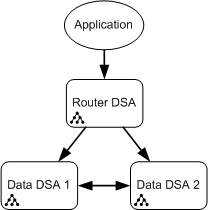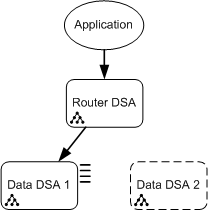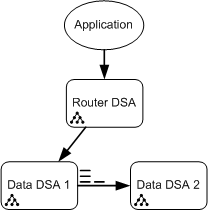Multiwrite is based on the idea that the multiwrite DSAs are usually functioning and connected. If one of the DSAs in the region shuts down or becomes disconnected, any updates are queued in another DSA's memory until the offline DSA becomes available once more.
After the DSA puts the update request in a queue, it sends a confirmation to the client. In effect, multiwrite reverts to a write-behind scheme until the offline DSA becomes available.
Important! A queued update is stored in memory only, and is lost if the DSA holding the queue is restarted.
The following diagrams show how a DSA in simple multiwrite system recovers.
A single router DSA passes client requests to two data DSAs, which replicate all changes to each other.


While DSA 2 is down, the following happens when the client application makes an update request:
DSA 2 is now out-of-date.

| Copyright © 2009 CA. All rights reserved. | Email CA about this topic |